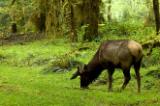 © Pete Saloutos/Panoramic Images (Washington Title Image Large)
© Pete Saloutos/Panoramic Images (Washington Title Image Large)

Washington State Wildlife Action Plan
Washington’s Ecoregional Wildlife Action Plans will implement the Comprehensive Wildlife Conservation Strategy (CWCS) and serve as the guiding framework in an adaptive management process. They will inform and integrate management projects conducted by WDFW in conjunction with its conservation partners to address conservation threats to Species of Greatest Conservation Need (SGCN) and their associated priority habitats.
By the Association of Fish and Wildlife Agencies
Although the Washington Department of Fish and Wildlife (WDFW) is driven by planning at many different levels, from multi-agency salmon recovery plans to individual Wildlife Area plans, creation of the State Wildlife Grants program and the CWCS requirement provided an opportunity for WDFW to undertake an agency-wide effort to reassess wildlife conservation priorities and set a new direction for the future. Specifically, the CWCS process provided the impetus for a thorough re-evaluation of priorities for species and habitat conservation, a transition from statewide to ecoregional conservation, acceleration of the evolution from species management (fine filter) to a more ecosystems-based management approach (coarse filter), and expanding the emphasis on biodiversity conservation, at the statewide and ecoregional scales.
In times of diminishing habitat and declining revenues for conservation, it has been important for WDFW to initiate a new round of strategic planning and to begin to establish new ground rules for how the state and its conservation partners prioritize species, habitats and conservation actions, as well as for where the state directs future funding and human resources to address these priorities.
Wildlife Highlights
Washington is home to a large variety of fish and wildlife species -- a natural heritage important to the long-term health and economic security of every resident of the state. However, changes to the landscape and native habitat, primarily as a result of human activity, have put many of these species at risk. There is a great need to be proactive, to protect what the state already has, and to keep common species common before they become endangered or at risk.
Primary Challenges to Conserving Wildlife in Washington
The following major influences have the greatest impact on Washington’s fish, wildlife and habitat base:
- Habitat loss through conversion, fragmentation and degradation
- Invasive alien plant and animal species
- Water quantity—allocation and diversion of surface water
- Water quality issues
- Salmon recovery
- Forest conservation and management practices
- Agricultural and livestock grazing practices
- Disease and pathogens
- Inadequate data on wildlife species, populations, and habitat
Habitat Loss
Habitat conversion, fragmentation and degradation together pose the most serious statewide threat to Washington’s native fish and wildlife resources. Since statehood in 1889, these combined problems have cost the state more than half of its highest priority functioning habitats, including an estimated 70 percent of estuarine wetlands, 50 to 90 percent of riparian habitat, 90 percent of old growth forest, 70 percent of arid grasslands, and more than 50 percent of shrub-steppe.
Invasive Species
Invasive alien plant and animal species constitute a severe and growing threat to Washington’s native wildlife, habitat and biodiversity; second only, many believe, to habitat fragmentation. Everywhere in the state, aggressive non-native plants and animals are displacing native species, profoundly altering natural systems and affecting the state’s economy and human health.
Working Together for Washington’s Wildlife
The Washington Department of Fish and Wildlife met with existing WDFW advisory councils, an appointed CWCS Advisory Committee, federal and state agencies, Washington Indian tribes, the Governor’s Office, key legislators and the Washington State Association of Counties on many occasions. WDFW met with a wide range of agencies and organizations in the initial outreach phase, but the main outreach focus was on public and private agencies and organizations with special responsibilities for fish and wildlife conservation. Special outreach efforts were directed toward conservation partners such as The Nature Conservancy, Audubon Washington and Defenders of Wildlife, as well as private timber and agriculture groups, which are regulated and have a direct influence on Washington’s rural landscape.
A CWCS Advisory Committee was appointed by the Director of Fish and Wildlife and met periodically throughout the development of the CWCS. The committee included professionals experienced in their respective industries and fi elds. They provided honest, constructive feedback and served as a valuable sounding board for development of the CWCS.
WDFW sent out a statewide press release announcing that the draft CWCS would be posted on WDFW’s website and a series of six public meetings would be held around the state. These public meetings were successful in giving interested stakeholders an opportunity to review and ask questions about the draft CWCS. The public was also asked to provide comments on the draft CWCS via our Washington CWCS website. Follow-up meetings were scheduled with major conservation partners, including the Washington Department of Natural Resources, U.S. Fish and Wildlife Service, the USDA Forest Service, and Indian Tribes with significant land holdings.
A number of outreach tools were developed by WDFW prior to publicizing the CWCS process. These include the CWCS website, a variety CWCS PowerPoint slideshows tailored to fit different audiences, and two color brochures: one describes the Washington CWCS, and the other illustrates the interactive relationships between the CWCS and other planning efforts at different scales.
The Association of Fish and Wildlife Agencies represents all of North America’s fish and wildlife agencies, promotes sound management and conservation, and speaks with a unified voice on important fish and wildlife issues.





